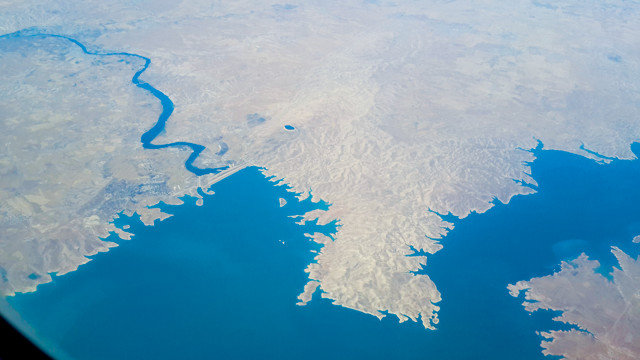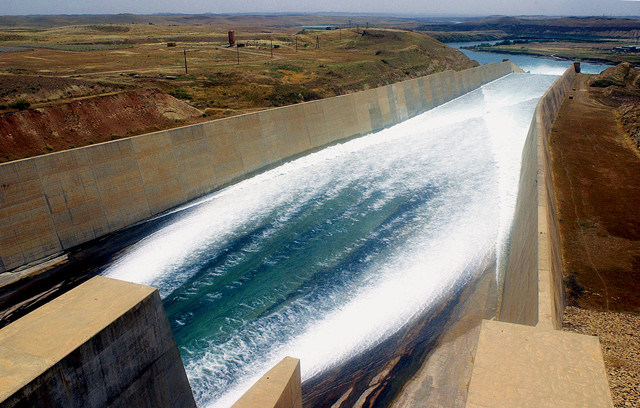
by Terri Cook Thursday, May 14, 2015

Mosul Dam (left of center) impounds a large reservoir on the Tigris River and provides much of Iraq's power and water. Credit: ©Ali Haidar Khan, CC BY-SA 3.0.

The main spillway at Mosul Dam. Credit: U.S. Army photo by Staff Sgt. Brendan Stephens.
Much of Iraq’s national power grid, as well as its irrigation and municipal water supplies, depend on Mosul Dam, a large earthen structure on the Tigris River about 70 kilometers upstream from Mosul, Iraq’s third-largest city. However, the dam, constructed in the 1980s, was built upon a geologically weak foundation, raising worries about its safety.
Concern spiked last summer when the militant Islamic group ISIS captured Mosul Dam. Although the takeover was brief, lasting about 10 days, the group controlled the dam long enough to renew fears that a potential catastrophic failure could occur if vital maintenance were halted. Such a catastrophe would cut off electricity for roughly 2 million people and potentially cause severe flooding in villages and cities downstream, like Mosul and Baghdad. The consequences would “include a huge loss of life,” says Lillian Wakeley, a consulting geologist and former engineering and environmental geologist for the U.S. Army Corps of Engineers, who guided a detailed study of Mosul Dam from 2006 to 2007.
The biggest source of concern is the siting of the dam, which was chosen for political reasons rather than engineering suitability, Wakeley says. The foundation and abutments were built upon alternating units of limestone, marl, anhydrite and gypsum. And since water began to pool in the reservoir in 1985, the anhydrite and gypsum have been dissolving continuously, despite extensive grouting during construction, according to the Corps of Engineers’ studies.
The studies concluded that the materials in the foundation and abutments are highly permeable, and that natural dissolution of these materials was accelerated by reservoir impoundment. This is because the shallowly dipping sedimentary beds in the east abutment promote the flow of reservoir water, which is undersaturated in calcium sulfate — the foundation’s most soluble mineral — into the subsurface rock units.
A 3-D model created by Wakeley’s team revealed that dissolution under the dam moves as a front and that grouting one segment of the foundation simply shifts the dissolution to adjacent segments. Water chemistry sampling has shown that the dissolution front is moving eastward (and downstream) at rates averaging about 17 meters per year, which is unheard of “under any other dam that I know of,” Wakeley says. “You just don’t build a dam where that kind of uncontrolled dissolution can happen.”
Over the last 25 years, engineers have been pumping grout beneath Mosul Dam to maintain its stability, filling in both pre-existing and new sinkholes, plus smaller voids created as soluble minerals dissolve from its foundation. “If they stop grouting for an extended period, piping will develop through the east abutment and the dam will fail,” Wakeley says, referring to water-permeable passages that could form in the rock connecting one side of the dam to the other. The dam thus operates every day in what she terms “crisis mode.”
Dam grouting in many parts of the world has advanced to a computer-controlled, state-of-the-art technique, and in 2006, the U.S. Department of State purchased an advanced grouting system for Mosul Dam. But as of 2008 — the most recent visit by a member of the U.S. Army Corps of Engineers research team — most of the system hadn’t been installed, parts were being stolen or sat deteriorating in the desert, and the Iraqis didn’t have the infrastructure to install the system on the critical east abutment, Wakeley says. Since then, she adds, it has been almost impossible for U.S. scientists to access the dam.
© 2008-2021. All rights reserved. Any copying, redistribution or retransmission of any of the contents of this service without the expressed written permission of the American Geosciences Institute is expressly prohibited. Click here for all copyright requests.